Bitcoin Repeating This Price Pattern Of Late 2019? Watch This
29 March 2023 - 2:40AM
NEWSBTC
As a result of the lawsuit filed by the Commodity Futures Trading
Commission (CFTC) against the world’s largest crypto exchange
Binance, the Bitcoin market is currently experiencing a high level
of uncertainty. After yesterday’s 5% crash within an hour, the BTC
price is currently struggling to make it past the $27,000 mark, yet
Bitcoin is up 63% year-to-date. BTC Repeating The Price Action Of
Late 2019? Analyst @tedtalksmacro sees many parallels in the
current price trend and macroeconomic environment to the period
from September to November 2019, when the Bitcoin price
consolidated between $10,500 and $6,500. “Just like every other
Bitcoin cycle, the current one has its nuances,” notes Ted, who
sees the first similarity in the US Federal Reserve’s (Fed)
interest rate policy. In 2019, the Fed made three rate cuts by
October. It also began expanding its balance sheet in September.
The scenario is somewhat similar to today’s. Currently, the Fed has
already begun balance sheet expansion – according to the prevailing
opinion of experts – with its Bank Term Funding Program (BTFP) and
expanded swaps with five other central banks. Even though the Fed’s
dot plot does not include any rate cuts in 2023, the market is
calling it a bluff and is pricing in rate cuts of 100 basis points
by the end of the year. Related Reading: CFTC Vs. Binance:
Cumberland Outlines 3 Scenarios For Bitcoin And Crypto Bitcoin
price trends are also similar. In 2019, the price had hit a bottom
after moving 83% away from the all-time high (ATH). This was around
500 days before the next halving in 2020. In 2023, the price
bottomed after moving down 78% from its ATH. Like clockwork, the
BTC price again found its bottom around 500 days before the 2024
halving. “Consistencies between cycles are new ATHs, echo bubbles,
bear markets and consolidation phases; each time these phases play
out slightly differently for reasons other than price,” explained
Ted, who shared the chart below. Further, the analyst notes on the
chart that the 2021/22 echo bubble was more intense due to the FTX
collapse and therefore outperformed the 2018 echo bubble by a
multiple. In addition, Ted speculates that the COVID black swan
price action should not repeat this cycle unless another black
swan, such as a third world war, occurs. In conclusion, he states:
If you’re betting on new lows from here, it’s becoming clear that
you’re betting on this time being different (I’ll never speak in
absolutes, but betting against history typically doesn’t work out
well). Similarities To 2020’s Bitcoin FUD Renowned analyst Andrew
Kang takes a similar view. In a recent tweet, he drew attention to
the current similarities to the year 2020. The year 2020 was marked
by numerous regulatory FUD history surrounding Bitcoin. Related
Reading: Bitcoin Mid-Term Holders Move 50,000 BTC, Bearish Signal?
In October 2020, the CFTC opened its case against BitMEX and its
founders. A short time later, the Chinese government attacked OkEX
and Huobi. After a quick recovery, markets faced a barrage of
regulatory FUD from US and Chinese regulators, as Kang notes. The
US government went after Arthur Hayes and Bitmex. The Chinese
government went after OKX and Huobi executives. Markets could not
break below $10k and climbed the wall of worry. “Markets could not
break below $10k & climbed the wall of worry,” says Kang, who
also wrote recently: Global crisis, markets panicked, months of
long positioning flushed out, only truly convicted holders remain,
sellers in disbelief and traders ready to fade all
rallies. Same playbook, just 3 years later. At press time, the
Bitcoin price was at $26,895, still struggling to shrug off the
Binance news. Featured image from iStock, chart from
TradingView.com
Bitcoin (COIN:BTCUSD)
Historical Stock Chart
From Mar 2024 to Apr 2024

Bitcoin (COIN:BTCUSD)
Historical Stock Chart
From Apr 2023 to Apr 2024
